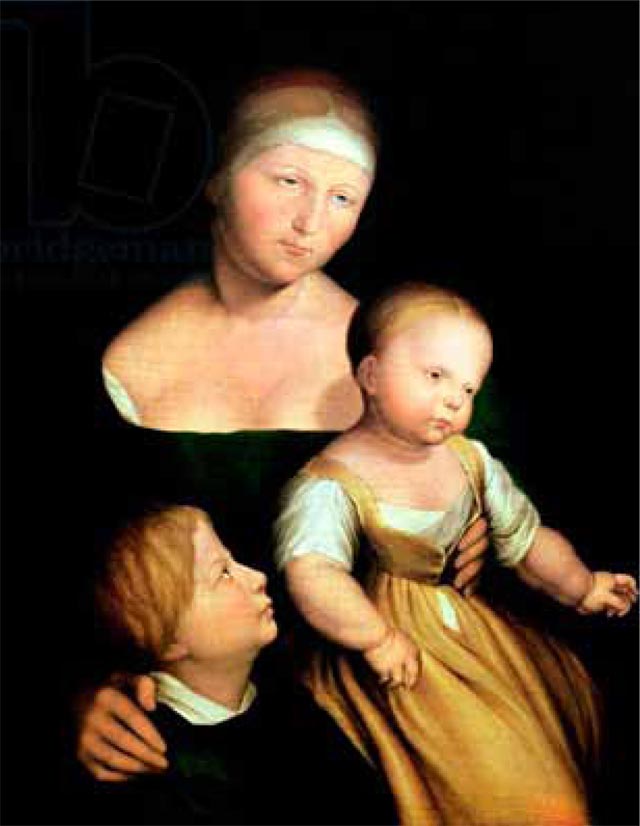My Favourite Painting: Anna Chancellor
Anna Chancellor chooses her favourite painting for Country Life.


Portrait of the Artist’s Family, about 1528/29, 30in by 25in, by Hans Holbein the Younger (1497/98– 1543), Kunstmuseum, Basel, Germany. Bridgeman Images.
Anna Chancellor says: ‘I can hardly bear this painting–it punched me in the solar plexus when I first saw it. It’s an unbelievably modern portrait in a way, so human. I feel that the faces are all so familiar. I think to myself “why did Holbein paint it?”. The figures look so distraught, but perhaps the painter is so involved in the situation that he doesn’t even notice–apparently, he was away from his family a lot. The wife really interests me; she’s almost got a squint, but then there’s her décolletage–she’s sexy as well. And you can see that the young boy in profile bears the responsibility of his fatherless family. Is this painting Holbein’s apology to them?'
Anna Chancellor stars in South Downs/The Browning Version at the Harold Pinter Theatre, London SW1, from April 19 to July 21.
Art critic John McEwen comments: 'Holbein’s wife, Elsbeth Binsenstock, is shown with their children Philipp and Katharina. Until this picture broke with convention, portraits proclaimed the eminent social status of sitters. Holbein, son of a distinguished painter, was of sufficient importance for his family to be worthy of such formal recognition. Instead, this portrait reveals nothing that could indicate social class or position. On the contrary, his wife looks far from her best, and the children are allowed their own unglossed individuality.
In addition, the pose is endearingly protective. That it is painted on paper complements the informality. At some date, the figures were cut out and glued to a wooden panel. Recent analysis supports the theory that quite a lot of the original composition is missing, the boy possibly a kneeling figure looking towards his father at an easel. This interpretation fits with the suggestion of a religious reference —the Madonna and Child painted by St Luke, patron saint of artists. Elsbeth was a widow with a son when she and Holbein married.
In 1526, Holbein visited England, staying as a guest of Thomas More on the recommendation of their mutual friend Erasmus of Rotterdam, whom Holbein had often painted in Basel. Holbein returned to Basel, his adopted city, in 1528, then went back to England for good in 1532. He was appointed Henry VIII ’s Court painter in 1536, and died in London seven years later. In his will, he left provision for the care of two illegitimate children born in England.'
This article was first published in Country Life, April 4, 2012
Sign up for the Country Life Newsletter
Exquisite houses, the beauty of Nature, and how to get the most from your life, straight to your inbox.
Country Life is unlike any other magazine: the only glossy weekly on the newsstand and the only magazine that has been guest-edited by HRH The King not once, but twice. It is a celebration of modern rural life and all its diverse joys and pleasures — that was first published in Queen Victoria's Diamond Jubilee year. Our eclectic mixture of witty and informative content — from the most up-to-date property news and commentary and a coveted glimpse inside some of the UK's best houses and gardens, to gardening, the arts and interior design, written by experts in their field — still cannot be found in print or online, anywhere else.
-
 ‘It had the air of an ex-rental, and that’s putting it politely’: How an antique dealer transformed a run-down Georgian house in Chatham Dockyards
‘It had the air of an ex-rental, and that’s putting it politely’: How an antique dealer transformed a run-down Georgian house in Chatham DockyardsAn antique dealer with an eye for colour has rescued an 18th-century house from years of neglect with the help of the team at Mylands.
By Arabella Youens
-
 A home cinema, tasteful interiors and 65 acres of private parkland hidden in an unassuming lodge in Kent
A home cinema, tasteful interiors and 65 acres of private parkland hidden in an unassuming lodge in KentNorth Lodge near Tonbridge may seem relatively simple, but there is a lot more than what meets the eye.
By James Fisher
-
 My favourite painting: Allan Mallinson
My favourite painting: Allan MallinsonMilitary historian Allan Mallinson picks an image of 'faith, generosity and ultimate sacrifice'.
By Charlotte Mullins
-
 My Favourite Painting: Piet Oudolf
My Favourite Painting: Piet Oudolf'One cannot sense whether he is far out on the ocean or closer to shore, or what he may be watching or feeling in that moment as he stares towards the beach.’
By Country Life
-
 My Favourite Painting: Mary Plazas
My Favourite Painting: Mary Plazas'There is compassion, awe, humility, a knowing yet a questioning in the glistening eyes. It moves me, it inspires me beyond the need to know.’
By Country Life
-
 My favourite painting: Robert Kime
My favourite painting: Robert KimeRobert Kime shares his fondness for New Year Snow by Ravilious
By Country Life
-
 My Favourite Painting: Anna Pavord
My Favourite Painting: Anna PavordAnna Pavord chooses a picture which reminds her of where she grew up
By Country Life
-
 My favourite painting: The Duchess of Wellington
My favourite painting: The Duchess of WellingtonThe Duchess of Wellington chooses her favourite painting for Country Life.
By Country Life
-
 My favourite painting: Maureen Lipman
My favourite painting: Maureen LipmanMaureen Lipman chooses her favourite painting for Country Life.
By Country Life
-
 My favourite painting: Jacqueline Wilson
My favourite painting: Jacqueline Wilson'I looked at this painting and decided to write about a Victorian circus girl one day'
By Country Life